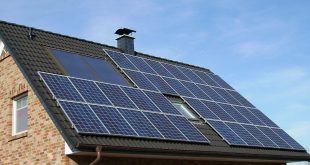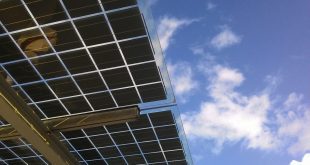Energy efficiency programs save UC $21 million per year
Improved light controls, such as those that are part of UC Davis’ Smart Lighting Program, are among ways UC campuses are improving energy efficiency in existing buildings.
By Harry Mok
UC has won national praise for its 50 LEED-certified facilities, the most of any U.S. university. Many are considered shining examples of the latest in energy-efficient technology.
But most UC campus buildings were constructed long before LEED green standards and conservation took hold. Making those more efficient entails doing much more low-profile things — like fixing leaky steam pipes, making sure air conditioning doesn’t run in the winter and swapping incandescent bulbs for the latest in lighting technology.
Since January 2009, the 10 UC campuses have initiated some 400 projects to improve the efficiency of buildings, in some cases using technology developed by UC researchers. Their goal: Cut energy use, costs and emissions to year 2000 levels by 2014.
The results so far have saved campuses more than $21 million annually compared to what they otherwise would have paid for energy. For a system that uses about 250 megawatts of power a year, about the same as a medium size city, the impact of all the discrete fixes adds up.
“We were doing energy efficiency over years and have never stopped doing it,” said John Dilliott, campus energy manager at UC San Diego. “The huge effort to do it at all campuses, all at once, has made it a big push, as well to get everything done in next few years (to meet greenhouse gas emission goals).”
Spurring this collective drive is the UC system’s Strategic Energy Plan, implemented in 2008, which identified 2,700 potential projects, of which 900 were found most viable financially. The cost of these projects was estimated at $250 million, yielding an expected $40 million annually in avoided energy costs when they are completed.
Teaming up to conserve
A portion of the financing for these projects comes from the Higher Education Energy Efficiency Partnership, begun in 2004 with the California State University system and the state’s four investor-owned utilities. The utilities provide up to $60 million in incentive grants for efficiency projects if UC delivers 187 million kilowatt hours and 10.8 million therms in annual energy savings — enough to power 30,000 homes — by the end of 2011.
From January 2009 through September 2010, completed efficiency projects and those under construction are estimated to be saving 94.4 million kilowatt-hours and 7.6 million therms in energy, resulting in 71,600 metric tons of annual greenhouse gas reduction, according to UC’s annual sustainability report.
The utility incentives provided the funding, and UC systemwide sustainability goals provided the impetus for campuses to embark on large-scale efforts to improve energy efficiency.
“An important key to this whole thing is the partnership program with the utilities,” Dilliott said. “Without the incentives, we wouldn’t have access to financing, and the financing is what makes it possible.”
A state law scheduled to take effect in January that creates a cap and trade system for carbon emissions may provide additional incentive. Large institutions such as UC likely would face a fee for its emissions. While details for implementing Assembly Bill 32 have not been finalized, it is to UC’s financial advantage to cut its carbon footprint as much as possible, according to Maric Munn, director of facilities management for UC San Francisco.
Those factors, along with the need to save money in an era of budget cutting, are pushing UC to be as energy efficient as possible.
“It’s been really helpful in getting people to say, ‘Yes, we can do this, this makes sense financially and the utilities will help us do this,’ ” Munn said.
The utility grants also have funded the installation of what’s called monitoring-based commissioning, which tracks how much energy a building’s major systems are using. UC researchers at the California Institute for Energy and Environment and the Lawrence Berkeley National Laboratory developed the technique in the 1990s and it has been adopted as an industry standard.
Data from monitoring-based commissioning allow facilities managers to identify equipment that’s not operating properly, and it is one of the best ways to conserve energy in a building, according to Munn.
The monitoring can detect energy spikes or dips that help identify equipment in need of repair or replacement. The system of monitors can also tell when room temperature is too hot or too cold, helping building managers balance energy efficiency with the comfort level of occupants.
“It’s looking at how systems work with one another and tuning them to be most efficient,” Munn said.
Getting smart about lights
Lighting has the potential for large energy savings and makes up about a quarter of the state’s electricity consumption, according to the California Public Utilities Commission.
UC Davis is the first large institution to commit to a state mandate to cut electricity use from lighting by 60 percent or more by 2020. The campus instituted a Smart Lighting Program in 2010 to reach that goal. The Higher Education Energy Partnership will fund $4 million of the $39 million cost for the UC Davis program with the remainder paid for by energy savings of $3 million per year.
LED and induction lighting combined with occupancy-sensor controlled systems has been installed in parking structures and lots, and several other buildings on campus. Upgrades to more efficient exterior and interior lighting throughout the campus are planned.
Many of the technologies being used were developed with the California Lighting Technology Center, based at UC Davis. Director Michael Siminovitch is a professor of lighting design at UC Davis, and the campus has served as a willing and convenient test ground for new technologies.
“This has been a more collaborative effort than we’ve done in the past,” said Kelly Cunningham, outreach director for the lighting center. “The campus was our proving ground from day one.”
At UC Davis, the new lamps and other equipment will last five to 10 times longer than previous technologies. Lamps that had been replaced every two or three years now won’t need to be changed for 10 or 15 years, resulting in fewer calls to maintain the thousands of lights on campus and fewer trips for workers in their trucks, which helps the campus cut a smaller carbon footprint, according to Chris Cioni, associate director of utilities facilities management at UC Davis.
In addition, in most cases, the LED lamps provided a brighter, better quality light than was previously used, and the new lights also enhanced safety, according to focus group surveys and consultations with campus police, according to Cioni.
“The lighting program had all these attributes and, oh yes, it also saves energy,” Cioni said.
The lighting center is also working with UC Irvine on a campuswide exterior lighting retrofit and smaller upgrades at UC Santa Barbara and UC San Francisco.
“It’s an exciting time to be working with something that most people overlook unless it doesn’t work correctly,” Cunningham said.
Along with lighting, some of the biggest users of energy at universities are research laboratories, which with their specialized equipment and ventilation systems, can use four to five times more energy than a similarly sized classroom or office and can account for as much as two-thirds of a campus’s energy consumption.
“If you want to increase energy savings, reduce greenhouse gas emissions and reduce your carbon footprint, the real place to do that is in laboratories,” said Matt Gudorf, campus energy manager at UC Irvine.
Much of the energy used by labs is from ventilation systems that take in, cool, filter, heat, dehumidify and distribute air in a lab building, then exhaust it at high velocity as a safety measure. Typically, laboratory buildings are self-contained environments that exchange their entire air volume six to 12 times per hour, 24 hours a day, regardless of occupancy or air quality. More efficient ventilation systems synchronize building controls with occupancy and indoor air-quality sensors reduce the number of air changes per hour.
Other new technology and advances in building practices are helping new and retrofitted labs become more efficient and sustainable. These facilities have features such as monitoring-based commissioning, centralized ventilation controls, new ultra-low temperature freezers that use less electricity, high-efficiency fume hoods, low-energy lighting and recycled construction materials.
New facilities at UC with these high-tech features include the August A. Busch III Brewing and Food Science Laboratory and Department of Viticulture and Enology Teaching and Research Winery at UC Davis’s Mondavi Institute, UC Irvine’s Sue and Bill Gross Hall Stem Cell Research Center and the Ray and Dagmar Dolby Regeneration Medicine Building at UC San Francisco. They have all won accolades for their sustainable design and energy efficiency.
Future technologies
On the horizon are renewable power sources such as solar that hold great potential to cut carbon emissions and UC’s reliance on the state energy grid. Currently, the upfront investment and logistical hurdles in deploying them on a large scale are an economic challenge, said Dirk van Ulden, associate director for energy and utilities at the UC Office of the President and the overall manager of UC’s Strategic Energy Plan.
However, the possible costs of complying with state greenhouse gas emissions guidelines are making the financial viability of renewable energy more attractive, van Ulden said.
“There is a significant cost associated with becoming carbon neutral but the University of California is committed and will achieve that goal by exploring life-cycle least cost options,” van Ulden said. “In the interim, we have to make campuses more energy efficient.”
So for the time being, aggressively applying monitoring-based commissioning and making infrastructure upgrades will be the easiest path to energy efficiency that cuts costs and carbon emissions.
“It’s like taking your car in for a tune-up,” van Ulden said. “It helps your gas mileage, and when you go in, the mechanic may find something else wrong. It may cost more to fix it, but in the long run it pays off.”
 Alternative Energy HQ solar power for homes, wind energy, and bio fuel issues
Alternative Energy HQ solar power for homes, wind energy, and bio fuel issues







